As soon as you discover that you need to eliminate gluten from your diet, you begin dreaming of cinnamon rolls and buttery bread sticks.
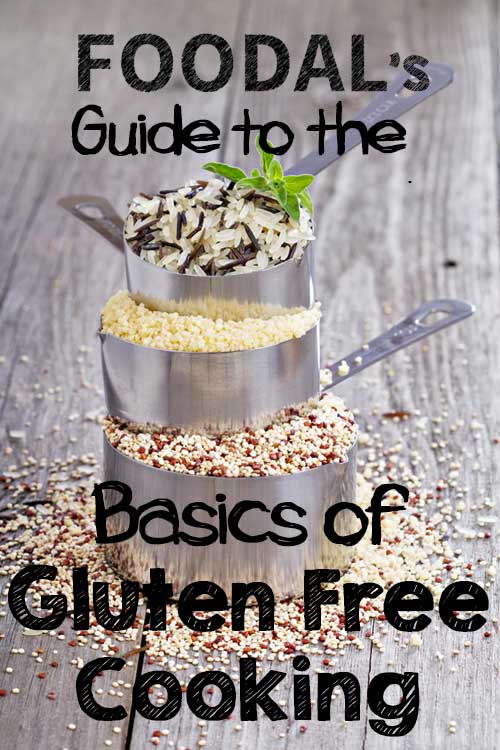
All of a sudden you notice every single bakery near your home, and when you walk through the grocery store you are suddenly mesmerized by the cakes, cookies, and items of yeasty goodness that you never cared about before.
So you make a beeline to that crunchy health food section where all of the outdoorsy people (or diabetics) shop, and you pick up a loaf of gluten free bread that costs something close to $73.
You head home to make a sandwich.
Then you discover that this “bread” tastes nothing like actual food, and more like something that was gathered up off of the floor of a carpenter’s shop and glued back together.
Seriously. Being gluten free is hard.
And with rates of gluten sensitivity on the rise, this is becoming an increasingly common dietary trend.
Is There Any Good News?
Yes, there is hope!
It is possible to make amazingly delicious recipes in your own kitchen without the need for gluten anywhere nearby. And you may even find yourself cooking a bit healthier as well. You just need to know a few of the secrets.
Because gluten is found in anything that has wheat in it, and wheat is in a whole lot of things (which you may not have realized until you started reading SO many labels), it can be difficult to imagine cooking without any gluten at all. But it can be done.
So don’t be intimidated.
Really, though, it’s just a matter of understanding the way gluten works, and then learning how to mimic that in different ways.
Another factor to enjoying a gluten-free lifestyle is keeping an open mind.
Taking an opportunity to develop new habits and create new ways of doing things can benefit your life (and your health) in new and exciting ways and can lead into new dietary lifestyles such as paleo.
Secret Places Where Gluten Hides
In addition to products made from wheat, gluten may potentially be found in other grains such as barley, rye, spelt, kamut, and oats (Oats usually have to do with cross contamination rather than actual gluten in the oats) .
Triticale is another flour you may see on labels, which should be avoided because it is a hybrid of wheat and rye.
Derivatives of gluten-containing grains include malt, malt flavoring and malt vinegar, so be careful and read labels. And of course, gluten may also be in many packaged foods which you may not expect, such as gravies, sauce mixes, and thickening agents.
What Does Gluten Do?
Gluten functions as the sticky portion of the grain that holds everything else together, and cooking without it tends to cause a few problems. Because of this, simply swapping out the all-purpose flour in exchange for another type of gluten-free flour doesn’t exactly work.
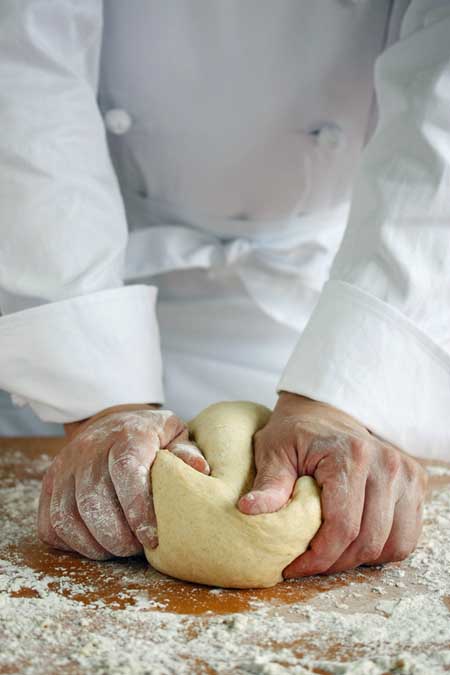
While a variety of gluten-free flours can work well in gluten-free recipes, they don’t exactly work as a direct substitute. It’s necessary to not only substitute for bulk, but also for stickiness.
Convert Recipes or Scrap Them and Start Over?
Sure, taking your grandma’s favorite recipe and substituting cup-for-cup is probably not going to work out very well. But that doesn’t mean you should give up on trying to convert your Nana’s recipe to gluten free.
Here are some tips for trying out your conversions:
- Add 1/4 teaspoon xanthan gum per 1 cup of gluten-free flour and blend evenly into dry ingredients.
- Increase fat (butter, margarine or shortening) up to 2 tablespoons and use fatty flours such as almond or hazelnut to keep the starch from feeling dry and sandy in your mouth.
- Adding liquid to a cookie helps to avoid the sandpaper issue and adds structure, but may result in a texture that is more cake-like.
- Yeast breads can be almost impossible to convert, so it may be best to let someone else do the test kitchen conversion work for you and find a pre-existing gluten-free yeast bread recipe online.
- Cakes can be pretty easy to convert. Add an extra egg for structure and to provide adequate hydration, plus 1/4 teaspoon xanthan gum per 1 cup of flour.
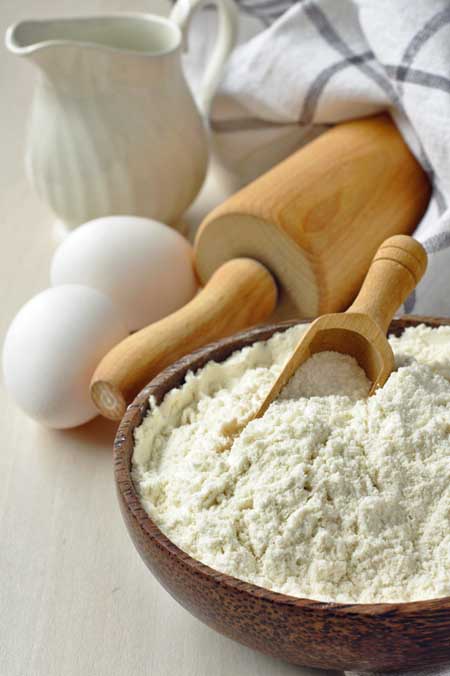
- High protein flours often work better for baked goods, as they contain more substance. Rather than using rice flour, try amaranth, millet, and sorghum in a blend. And consider using oats as a binder for savory recipes, like gluten-free meatloaf.
- Eggs help with protein and moisture. They also add leavening, helping bread to rise and become fluffier.
- Measure by weighing rather than using cup measures. Rather than measuring by volume, which can be extremely inaccurate if the four is compacted or fluffy, try weighing on a kitchen scale. 1 cup flour = 140 grams of all-purpose gluten-free flour.
- Let cake and muffin (quick bread) batters rest for up to 15 minutes prior to baking, to allow the full hydration of xanthan gum and starches. This makes the batter thicker and provides more gluten-like results.
- Work with room temperature ingredients. Milk, butter and eggs should be placed on the counter for around 2 hours prior to baking. If you keep your gluten-free flour in the freezer, be sure to leave it out overnight in order to bring it to room temperature.
- Add chocolate chips, raisins or nuts after the rest time and then fold in carefully. This prevents them from sinking.
What are the Safe Gluten-Free Flour Options?
Some of these flours are basics that you can easily get at the grocery store. Others may be something you’ll begin making yourself, with a blender. Whatever the case, the gluten-free flour options available to you probably go way beyond what you might expect!
- Almond
- Amaranth
- Arrowroot
- Buckwheat
- Coconut
- Corn
- Fava Bean
- Garbanzo bean (chickpea)
- Hazelnut
- Millet
- Oats (if not cross contaminated)
- Pea
- Pecan
- Potato starch or potato flour
- Quinoa
- Rice flour (brown, white, sweet white)
- Romano (cranberry)
- Sorghum
- Soy
- Tapioca starch
- Teff
Do make sure any of the flours you use are certified gluten free. Potential for cross contamination exists as early as the fields where the foods are grown, harvesting equipment, trucks where they are transferred, and facilities where they are processed.
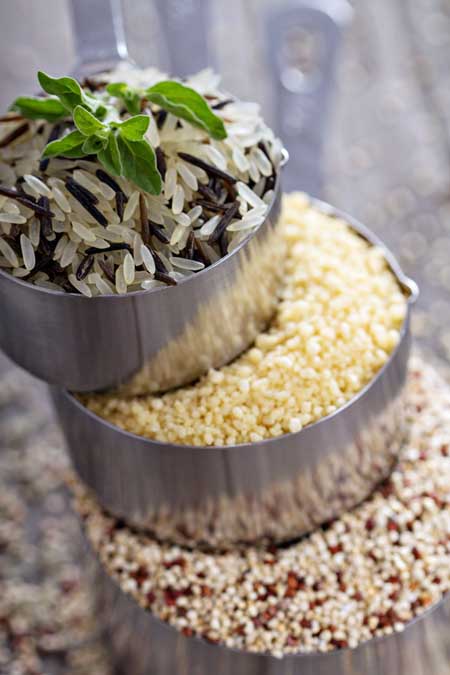
Oats are particularly difficult to predict as they are often grown and processed hand in hand with wheat products. So read the label to make certain you are getting what your body needs.
Other Possible Health Concerns
Xanthan gum (guar gum) adds texture and some stickiness. Although this is used in many gluten-free recipes, and it technically does not contain gluten, you should experiment with whether or not you have a sensitivity to these gums.
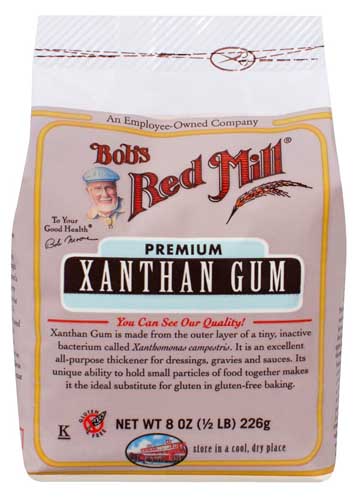
Foodal recommends Bob’s Red Mill Gum Xanthan available at Amazon
Cutting this out completely may help with your gut pain. To learn more about that gut of yours, read our article explaining the function of the microbiome, and you can best take care of it!
Because many non-wheat flours are lower in fiber (except for oats), you may find that you are not getting enough fiber in your diet. A gluten-free diet can make you irregular.
Use a combination of psyllium seeds, flax seeds and chia seeds ground together. Add just a pinch to your recipes to help with digestive system health.
Oats are the exception to the low fiber rule…
The high amount of fiber in oats may create a problem for those who are not accustomed to it. Sensitive digestive systems may have trouble getting used to this, so you may choose to blend several fours together rather than choosing only one.
Then, slowly work your way up to the higher fiber content based on what your body can handle.
Getting started with a gluten-free lifestyle doesn’t have to be scary. You can live without wheat!
All it takes is a bit of education and a measure of creative thinking. You’ll begin learning and experimenting with your own recipes in no time.
For a start, try our gluten-free pizza dough, or our amazing gluten-free, dairy-free, and egg-free recipe for soft and chewy paleo chocolate chip cookies! Or how about this tasty sorghum bread?
For more beginner cooking tips that will help you to adjust to cooking more at home in three simple steps, with or without gluten, read this post.
About Julie Workman
As a freelance writer for over 15 years, Julie Workman has been published in various magazines, books, and online media. She holds a college degree in Home Economics which she uses every day in overseeing her household and making her home a happy place for her family.




These tips are very helpful. They are the keys that open the doors on a very frustrating journey. I am vegan and attempting to soothe my gut woes with gluten free! So, it is a double effort.
I did not know the point about the fiber, so II am grateful for that.
One great thing is the many different flours now available to use. Now I can use them intelligently. Thanks!
I have several friends who are gluten free, and the guide to the alternatives is very handy. It will take some practice to try recipes with other flours, but I am sure after a while people won’t notice the difference too much, especially in bread and pizza bases.
One of the biggest is soy sauce. MOST, but not all, soy sauce has gluten in it, and an alarmingly high number of foods seems to have soy sauce. This is not limited to Asian food, I’ve found. Either way, it’s important to know the difference between Tamari and Soy Sauce. If you are looking to go gluten free, Tamari is the way to go here. Just my 2 cents.
Thanks so much for all of these tips…it has been difficult to bake with any predictability re: the texture. This conversion and how-ingredients-work guide will be a very nice boon to my kitchen toolbox. Thanks!
Thank you for the gluten free baking tips. I was diagnosed with celiac disease a few years ago and have been gluten free since being diagnosed. From my experience, once I stopped eating all glutens I felt so much better that I have never been tempted to go back! I was unaware of a couple of the flours mentioned in this article, such as romano and pecan. I am excited to try them next time I bake some gluten free goodies!
Thank you so much for this guide… I might have gluten intolerance and I was terrified of changing my eating habits. As you said, it’s incredibly hard to avoid wheat. I especially enjoyed your tips on converting recipes – I’m relieved that I don’t have to scrap everything.
Eek, I don’t bake at all, I’ve just been telling myself “you are allergic to wheat” “wheat makes you sick” and I’ve slowly managed to remove wheat from my life. I support the local bakers that offer wheat free alternatives, and I’m grateful to them for all their effort. I think it’s much harder for families with children and I have huge respect for mommies that are committed to baking and feeding their families the best they can.
Thank you for these great tips! I am not gluten intolerant myself, but have some friends who are, when baking for them I have always used almond flour. I will definitely try some of these other flours next time.
For several months I have been thinking of cutting gluten out of my own diet, but it is hard to find substitutes since I love bread so much. I will start looking for recipes and continue experimenting in the kitchen.
Is there an alternative for xanthan gum, I can’t find it in my local supermarket.
I have found that making gluten free breads, doughs, and pastries that actually taste good requires a very long and tedious process of trial and error. Garbanzo flour might be perfect for one recipe but not so good for another, and so on. I like to experiment with a wide variety of gluten free flours, like almond flour, oat flour, amaranth, etc…
Thank you so much for this!
My doctor advised me to go gluten free to aid my dysfunctional thyroid and it felt like a death sentence since I am already lactose intolerant and allergic to soy…
Living gluten free would probably be even harder if you don’t know how to cook. I had to laugh at the little joke about that loaf of bread costing $73. I hate it when food companies price healthy options higher than the unhealthy ones. Then we wonder why people chose the unhealthy options when they can do otherwise. There are some places that might cater to gluten free but that may be few and far in between.
Thank you very very much for the article! My sister’s allergic to gluten and she’s got a hard time getting through gluten free cooking >n< I sent this link to her, hope it'll help 🙂